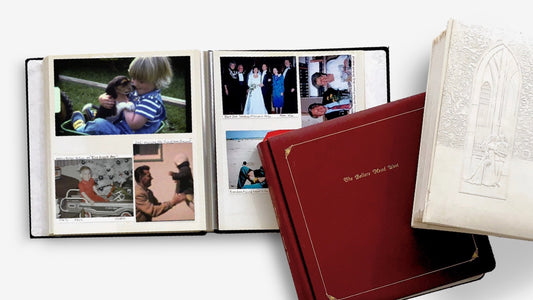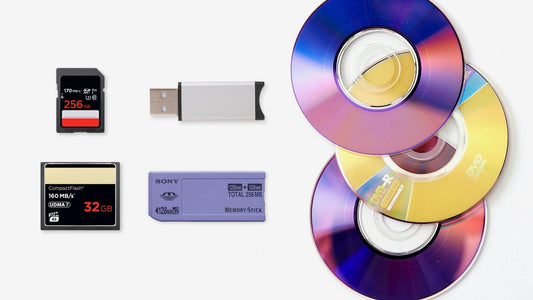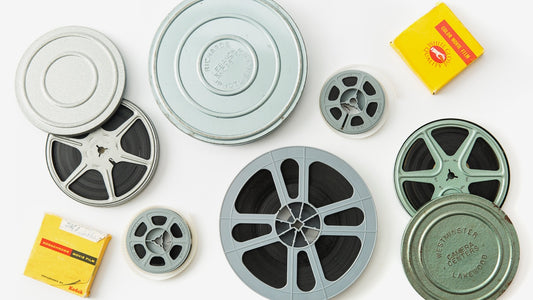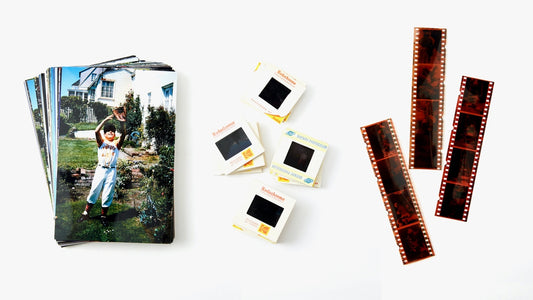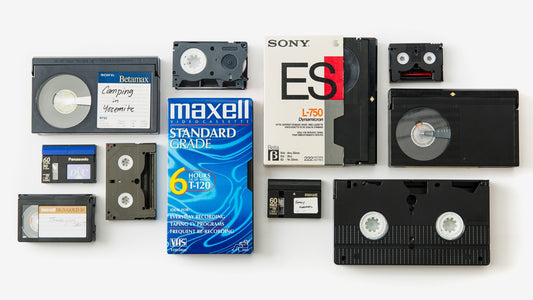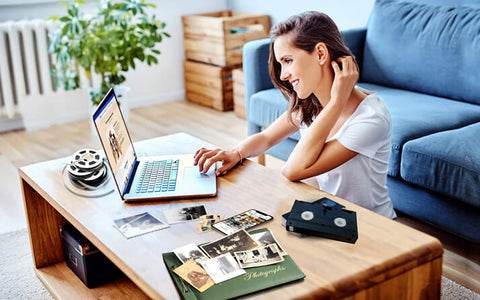Sharing your newly digitized memories can be so much more than just sending a link to a folder. It’s an opportunity to create new traditions and spark conversations that bring your family closer. Think of your digital archive as the starting point for fun, interactive experiences, like hosting a virtual watch party for old home movies or building a collaborative family timeline together. When done thoughtfully, sharing digitized media online becomes a creative way to celebrate your history. This guide is packed with practical tips and inspiring ideas to help you move beyond simple file storage and turn your collection into a hub for family connection.
Key Takeaways
- Choose a Platform That's Both Simple and Secure: Select a service that lets you share memories with a single link—making it easy for non-tech-savvy relatives—while also giving you control with password protection and specific viewing permissions.
- Create a Simple System for Organization: Before you share, group your files into logical folders by year and event (e.g., "1995/Summer Vacation") and use descriptive file names. This makes it easy for everyone to find specific memories without endless scrolling.
- Share Stories, Not Just Files: Go beyond simply sending links by creating shared experiences. Use your digitized photos and videos to host a virtual watch party, build a collaborative family album, or add comments with names and context to bring the memories to life for everyone.
What Makes a Sharing Platform Great?
Once you’ve digitized your precious memories, the next step is sharing them with the people you love. But with so many options out there, how do you choose the right one? The best platform for your family will do more than just store your files; it will make sharing a joyful and seamless experience for everyone, from the most tech-savvy cousin to a grandparent who’s just getting the hang of their new tablet. Think of it as creating a central, digital home for your family’s history—a place everyone feels comfortable visiting and contributing to.
When you’re comparing services, think about three key things: security, storage, and simplicity. You need a platform that protects your private moments, has enough room for all your high-quality videos and photos, and is easy for your entire family to use. A great platform removes the friction from sharing, so you can focus on reliving the moments that matter instead of troubleshooting technical issues. Finding a service that balances these three elements will ensure your memories are not only safe but also easily accessible for years of enjoyment. This choice is about more than just technology; it's about how your family will connect with its legacy for generations to come.
Look for Key Security Features
Your family photos and home movies are personal. The platform you choose should treat them with the same level of privacy you do. Look for services that offer encryption, which is essentially a way of scrambling your files so only people with permission can view them. This is a standard feature on most reputable platforms. For an extra layer of protection, find a service that lets you password-protect shared links or set them to expire after a certain date. This gives you complete control over who sees your memories and for how long, offering peace of mind that your private moments stay that way. True secure file sharing puts you in the driver's seat.
Check Storage and File Size Limits
After you’ve completed a video transfer, you’ll have high-quality digital files that can be quite large. The last thing you want is to hit a roadblock because your sharing platform can’t handle the file size. Unlike email, which often has strict attachment limits, most cloud storage services are built to handle big files. However, their storage capacity can vary widely. Check the limits for both individual file sizes and overall account storage. Many services offer a free tier with a certain amount of space, but for a lifetime of memories, you might need to consider a paid plan to ensure you have enough room for everything without having to compromise on quality.
Prioritize Ease of Use for Everyone
The most feature-packed platform is useless if your family finds it confusing. The goal is to share memories, not cause tech-support headaches. Look for a clean, intuitive interface that makes uploading and organizing files straightforward. The best options allow you to share a simple link that lets anyone view photos and videos, even if they don’t have an account. Also, consider how the platform notifies family members about new additions. Some services are better than others at letting everyone in a shared folder know when new photos from the family reunion have been added, which helps keep everyone connected and up to date.
The Best Platforms for Sharing Your Memories
Once you’ve digitized your home movies and photos, the next exciting step is sharing them with the people you love. But with so many options out there, which one is right for your family? The best platform is one that’s secure, easy for everyone to use, and has enough space for all your precious moments. Think about who you’ll be sharing with—tech-savvy cousins or a grandma who’s new to computers? Your answer will help you find the perfect fit. Let’s walk through the most popular choices so you can start sharing those memories today.
Your Go-To Cloud Storage Options
You’ve probably already heard of cloud storage services like Google Drive, Dropbox, or iCloud. These platforms are fantastic for storing all kinds of digital files, not just your newly digitized home movies. They work by letting you upload your files and share them with a simple link, which you can send to family members via email or text. It’s a straightforward way to give everyone access without having to send huge files directly. Most services offer a free starting plan, making it easy to test them out and see which interface you like best before committing.
Services Designed for Photos and Videos
While general cloud storage is great for files, some platforms are specifically built for visual media. A service like Dropbox is useful, but it treats a family video the same way it treats a spreadsheet. This can make it tricky to organize, find, and enjoy your memories, especially when you have a large collection. Platforms designed for photos and videos often have better gallery views, easier album creation, and sometimes even offer simple editing tools. If you want a more visual and intuitive experience for browsing through decades of family history, a media-focused service might be the better choice.
Keep it Private with Secure Networks
Your family memories are private, and you’ll want to make sure they stay that way. Reputable sharing platforms use encryption to protect your files, which is like a secret code that keeps them safe from prying eyes. Many services also let you add extra layers of security. For example, you can often share files securely by adding a password to your shared links or setting them to expire after a certain date. This gives you complete control over who sees your photos and videos, so you can share with peace of mind.
Compare Costs and Premium Features
Most cloud storage platforms operate on a "freemium" model. They offer a basic amount of free storage—typically between 2 and 15 gigabytes (GB)—which is perfect for getting started. However, digitized video files can be large, and you might find you need more space. Paid plans offer significantly more storage, often measured in terabytes (TB), which is enough for even the largest family archives. When comparing costs, look at the price per terabyte and any premium features included, like advanced sharing controls or ad-free viewing, to find the best value for your family’s needs.
How to Organize Your Digital Files
Once you have your precious memories digitized, the next step is creating a system that makes them easy to find and share. A little organization goes a long way, turning a digital shoebox of files into a browsable family archive. Instead of scrolling endlessly to find that one photo from a childhood birthday party, you’ll be able to pull it up in seconds. A good system also makes it much simpler for the whole family to navigate. The key is to keep it simple and consistent, so everyone can find what they’re looking for without needing a map.
Create a Simple Folder Structure
Think of your digital storage like a filing cabinet. You wouldn’t just toss every document in one drawer, and the same goes for your photos and videos. Start by creating a main folder for all your digitized media, then break it down with a clear, logical structure. A great way to start is by grouping files by year. Inside each year’s folder, you can create subfolders for specific events, like “Hawaii Vacation” or “Grandma’s 80th Birthday.” Be descriptive with your folder and file names. Instead of “IMG_1234.jpg,” rename it to “Mom and Dad Wedding - 1985.jpg.” This simple step makes your collection instantly searchable and understandable for anyone who browses it.
Use Tags to Find Photos Faster
Tags, or metadata, are like invisible labels you can attach to your files to make them easier to find later. Most photo applications and cloud storage services let you add tags for people, places, and keywords. You could tag every photo with the names of the people in it, the location (like “Beach House, NC”), and the event (“4th of July”). This way, you can quickly search for every picture of a specific person or every video from your annual family reunion. Taking the time to add detailed tags means you can find exactly what you’re looking for without having to remember which folder it’s in.
Manage Even the Largest Collections
It’s easy for a lifetime of memories to add up to thousands of files, which can feel overwhelming. The good news is that modern cloud storage platforms are designed to handle massive collections. Services like Dropbox, Google Drive, and OneDrive help you keep everything organized in one central place. You can create shared folders for different branches of the family, upload new content as you digitize it, and access everything from any device. Using a dedicated platform to manage your photo library prevents files from getting scattered across different computers and hard drives, ensuring your entire archive is secure and consolidated.
Build Albums for Easy Sharing
While folders are great for organizing your master archive, albums are perfect for curating and sharing specific collections. Think of an album as a hand-picked playlist of your favorite moments. You can create an album of highlights from a family trip, a collection of your favorite photos of the kids, or a tribute for a special anniversary. Many services allow you to create shared albums where different family members can add their own photos, leave comments, and relive the memories together. It’s a wonderful way to collaborate and turn a simple collection of photos into a shared family experience.
Make Sharing Easy for the Whole Family
Once your home movies and photos are digitized, the real fun begins: sharing them with the people you love. But choosing the right platform can feel overwhelming, especially when you’re trying to include everyone from your tech-savvy cousin to your grandma who just got her first smartphone. The goal is to find a solution that’s simple, secure, and brings everyone together. It’s not just about storing files; it’s about creating a shared space where your family’s story can be enjoyed by every generation.
Think about how your family communicates best. Do they prefer email, text messages, or a dedicated app? The right platform will meet them where they are, making it effortless for them to view, comment on, and even add their own memories to the collection. When sharing is easy, it happens more often, turning your newly digitized collection into a living, breathing family archive that everyone can be a part of.
Find a Truly Family-Friendly Option
Not all cloud storage is created equal when it comes to visual memories. While services like Dropbox are great for documents, they often treat your precious photos and videos like any other file, making them clunky to browse and enjoy. A truly family-friendly option is designed for media, offering features like thumbnail previews, easy-to-navigate galleries, and the ability to play videos directly in the browser. Look for platforms that prioritize the viewing experience, so your family can focus on the memories, not on figuring out how to download a file.
Help Less Tech-Savvy Relatives
The best way to include everyone is to keep things simple. For family members who aren't comfortable with new apps or complicated logins, the magic words are "a simple link." Most modern cloud services, like Google Drive or iCloud, let you share entire albums with a single, clickable link that you can send via email or text. This way, they can view everything without needing to create an account or install software. A little bit of setup on your end can make a world of difference for them, ensuring no one misses out on seeing those cherished moments.
Set Permissions and Control Who Sees What
Your family memories are private, and your sharing platform should help you keep them that way. Before you upload, explore the security settings. A good service will let you control who can view, edit, or download your files. You can often add a password for an extra layer of protection, set links to expire after a certain date, or even prevent people from downloading the original files to their own devices. These features give you complete peace of mind, knowing your memories are only being shared with the people you choose.
Use Features Made for Group Sharing
Sharing memories shouldn't be a one-way street. The best platforms encourage collaboration with features designed for groups. Look for options that let you create shared albums where everyone you invite can add their own photos and videos from an event. Many services also allow for comments, likes, and tags, turning a simple photo gallery into an interactive conversation. Some even have smart search tools that let you find photos based on who is in them or where they were taken, making it easier than ever to find exactly what you're looking for.
Keep Your Digital Memories Safe
Once your memories are digitized, the next step is making sure they stay safe for generations to come. Sharing is wonderful, but it comes with the responsibility of protecting your family’s privacy and ensuring these precious files are never lost. A little planning goes a long way in creating a secure digital home for your photos and videos. Here’s how to make sure your memories are protected, backed up, and shared only with the people you choose.
Use Passwords and Encryption
Think of encryption as a secret code that protects your files as they travel across the internet. Reputable cloud storage services automatically encrypt your data, but you can add another layer of security yourself. When you share a link to a folder of family vacation photos or a video of a wedding, always protect it with a strong, unique password. This simple step ensures that only the people you’ve given the password to can access your files. Many services also let you set expiration dates on shared links, which is a great way to grant temporary access for a specific event or project without leaving the door open forever.
Control Who Has Access
Not everyone needs the same level of access to your digital archive. Before you share, decide what you want people to be able to do with your files. Most sharing platforms give you precise control over permissions. You can grant “view-only” access to relatives who just want to see the photos, while giving “edit” access to a sibling who is helping you organize and label them. For extra security, you can even prevent others from downloading the original files. Taking a moment to set these permissions ensures your memories are enjoyed exactly how you intend, without any accidental deletions or unwanted copies being made.
Create a Reliable Backup Strategy
A single copy of a file is a recipe for heartbreak. Hard drives can fail and cloud accounts can be lost, so it’s essential to have a solid backup plan. A great rule of thumb is to keep your memories in at least three places. For example, you can save your digitized files on an external hard drive, upload them to a trusted cloud storage service, and keep a copy of your absolute favorites on a USB stick stored in a safe place. After you receive your digital memories from a photo transfer service, make backing them up your very first task. This redundancy gives you peace of mind knowing your family’s history is safe from any single point of failure.
Manage Your Privacy Settings
Sharing on public social media can feel easy, but it often means giving up control over your family’s privacy. For personal home movies and photos, it’s best to use a private, secure platform where you manage the audience. It’s also a good idea to have a conversation with your family about what everyone is comfortable sharing online. Establishing digital boundaries together helps ensure everyone feels respected and safe. By being mindful of your privacy settings and choosing the right platforms, you can share your cherished moments without overexposing your family’s personal information to the wider world.
Pro Tips for Smarter Sharing
Once your memories are digitized, the next step is sharing them with the people you love. But sending large files and organizing countless photos can feel like a chore. These simple tips will help you share your family’s precious moments more efficiently, so you can spend less time managing files and more time reminiscing.
Optimize Files for Faster Uploads
Digitized home movies, especially from older film reels, can create very large files. Trying to upload a massive video file can take hours, and it’s just as slow for your family to download. The solution is to compress the file, which makes it smaller without a noticeable drop in quality. You can use a free tool like HandBrake to shrink your video files before you upload them. This small step makes the sharing process much faster for everyone involved, especially for relatives with slower internet connections.
Upload Multiple Files at Once
If you have hundreds of photos from a recent album scanning project, uploading them one by one is out of the question. Most cloud storage platforms are designed to handle this. You can typically select entire folders of photos and videos and simply drag them into the uploader window. This batch-uploading feature is a huge time-saver. Once everything is uploaded into a single folder, you can share one simple link with your family, giving them access to everything at once instead of sending dozens of separate files.
Ensure It Works on Any Device
Your family likely uses a mix of devices—iPhones, Androids, tablets, and computers. To avoid the dreaded "I can't open this file" message, choose a sharing platform that works everywhere. Major cloud services like Google Drive and Dropbox have apps for nearly every device. When you share a link from one of these platforms, your relatives can view the photos and videos directly in their web browser or app without needing special software. This ensures everyone, regardless of their tech comfort level, can enjoy the memories without any hassle.
Automate Your Sharing Process
Instead of sending new links every time you add more photos, you can create a central, shared folder that updates automatically for everyone. Think of it as a living family archive. Simply create a folder in your cloud storage service, name it something like "Family Memories," and share the link with your relatives. From then on, any new files you add to that folder, like a newly digitized video transfer, will instantly become available to everyone who has the link. It’s a set-it-and-forget-it approach that keeps everyone in the loop.
Share More Than Just Files
Once your home movies and photos are digitized, the real fun begins. Sharing these memories is about more than just sending a link; it’s an opportunity to reconnect with family and create new traditions. Instead of letting your digital files sit in a folder, you can use them to spark conversations, share stories, and bring everyone together, no matter how far apart they are. Think of your digital archive as a starting point for creating new, meaningful experiences with the people you love most.
From hosting a virtual movie night to building a family history project together, there are so many creative ways to share your digitized past. These activities transform passive viewing into an interactive experience, strengthening family bonds and ensuring your most cherished moments are not only preserved but celebrated. Let’s explore a few ideas to get you started.
Host a Virtual Watch Party
Gather the whole family for a trip down memory lane by hosting a virtual watch party. Once you have your digitized videos, it’s easy to get everyone together online. Pick a date, send out fun invitations, and use a video conferencing tool like Zoom or Google Meet to share your screen. You can all watch that hilarious 1995 family vacation video or the heartwarming footage from your parents’ wedding at the same time.
The best part is hearing everyone’s real-time reactions, laughter, and shared stories. It turns a simple viewing into a live, communal event that bridges any distance. You can even make it a regular occasion, like a monthly "Throwback Movie Night," to stay connected and relive your favorite moments together.
Add Stories and Context to Your Memories
A photo or video captures a moment, but the story behind it is what truly brings it to life. When you share your files, take the time to add context that might otherwise be lost. Use the description or comment features in your sharing platform to jot down names, dates, locations, and a little bit about what was happening. Who was telling that joke that made everyone laugh? What was the story behind that crazy bridesmaid dress?
Labeling your files with descriptive names is also a huge help. Instead of "SCAN001," try "AuntCarol_Winning_BakeOff_1988." This small effort adds incredible value, especially for younger generations, and helps everyone in the family relive those moments more deeply.
Build a Collaborative Family Album
Turn your family history into a team project by creating a collaborative digital album. Many platforms, like Google Photos and Apple Photos, offer shared albums where multiple people can add their own photos, videos, and comments. This is perfect for collecting memories from a family reunion, holiday, or wedding, as you get to see the event from everyone’s unique perspective.
Encourage family members to dig up their own photos and contribute to a shared timeline. You can create albums dedicated to specific people, like a "Happy Birthday, Grandpa!" album, or themes, like "Family Summers at the Lake." It’s a wonderful way to pool your collective memories and build a richer, more complete picture of your family’s story together.
Use Your Photos to Stay Connected
Your digitized memories are a powerful tool for staying in touch. Instead of sharing everything at once, use individual photos and clips to spark daily or weekly conversations. Send a funny childhood photo to a sibling on their birthday, or post a sweet throwback picture of your parents on their anniversary and tag your relatives. It’s a simple gesture that can make someone’s day.
Using your memories this way keeps your family history alive and woven into your current relationships. It’s a fantastic way to strengthen relationships and remind your loved ones that you’re thinking of them. Starting a photo transfer project gives you a brand new library of content to share and connect over for years to come.
Helpful Features to Look For
When you’re choosing a platform to share your family’s precious memories, the sheer number of options can feel overwhelming. But it gets a lot simpler when you know what to look for. The right features can make the difference between a clunky, frustrating experience and a seamless way to connect with loved ones. Think about what will make sharing easiest for everyone, from your tech-savvy cousin to your grandmother who’s just learning to use her tablet.
Focus on platforms that prioritize simplicity, security, and collaboration. You want a tool that works quietly in the background, letting your family’s photos and videos take center stage. A great platform will help you organize your memories, share them securely, and ensure everyone feels included. Let’s walk through the key features that will help you find the perfect digital home for your family’s history.
Get the Most Out of Your Storage
Once you have your digitized memories, you need a place to store and share them. Look for a service that makes sharing simple, even with family members who don’t have an account. The best platforms let you share a whole album or a single photo with just a link. This means no one has to sign up for something new just to see the latest family photos. Also, pay attention to storage limits. Since your digitized home movies from a video transfer can be large, you’ll want to ensure your chosen platform offers enough space for your entire collection without charging a fortune.
Find Tools That Save You Time
The goal is to spend more time enjoying your memories, not managing them. Look for features that streamline organization, like shared folders. You can create one central place for a specific event, like a family reunion or a holiday, and invite everyone to add their photos and videos. This keeps all related files together, so you’re not hunting through endless emails or text threads to find a specific picture. It also makes it easy for everyone to see the latest additions without you having to send out constant updates. These simple organizational tools are a huge time-saver.
Understand Version Control
"Version control" might sound technical, but it’s a simple concept that’s incredibly helpful for families. It just means the platform keeps track of changes. Look for a service that notifies you when someone adds new photos to a shared album or comments on a video. This feature ensures everyone is looking at the most current collection of memories. It’s a great way to keep the whole family in the loop automatically, sparking new conversations as people discover recently added photos from a trip or find a long-lost home movie.
Improve Your Platform's Performance
Your family memories are irreplaceable, so security should be a top priority. Choose a platform that protects your files with encryption, which is like a digital lock and key that keeps your photos and videos private. A secure service ensures your files are protected while they’re being uploaded, stored, and shared. This peace of mind is essential when you’re dealing with personal memories. A trustworthy platform, like the service you chose to digitize your media, should extend that same level of care to how you share those files online.
Related Articles
- Archiving Old Photos: A Step-by-Step Guide
- How to Build a Digital Family Archive
- Create a Digital Family Tree: Tips and Tools
- 7 Best Super 8 to Digital Services
- Digitize Slides: The Ultimate How-To Guide
Frequently Asked Questions
My family isn't very tech-savvy. What's the simplest way to share my digitized memories with them? The easiest method for everyone is to use a platform that lets you share a single, clickable link. Most major cloud storage services offer this feature. You can upload an entire album of photos or a home movie, generate one link, and then text or email it to your family. They can click it and view everything right in their web browser without needing to create an account, download an app, or remember a password.
Should I use a general cloud storage service like Google Drive or one specifically for photos? It really depends on how you want to interact with your memories. General cloud storage like Dropbox is great for pure storage and file organization, treating your videos like any other document. However, platforms designed for photos often provide a much better viewing experience with beautiful galleries, easy album creation, and commenting features that make browsing more enjoyable and interactive for the whole family.
How can I be sure my private family videos stay private when I share them online? Your privacy is all about controlling who has access. Before sharing, look for security settings that let you password-protect your links. This ensures only people with the password can view your files. Many services also allow you to set permissions, so you can decide if people can only view the files or if they can also download or edit them. These simple steps give you complete control over who sees your family’s moments.
I have decades of photos and videos. What's the best first step to get them organized? The key is to start simple so you don't get overwhelmed. Begin by creating a main folder for all your digitized media. Inside that, create subfolders for each year. From there, you can make more specific folders for events within those years, like "1995 - Summer Vacation." This basic structure immediately makes your collection browsable and is a fantastic foundation you can build on later with tags or albums.
Do I really need to pay for a storage plan, or is a free one good enough? A free plan is a great way to get started and see if you like a platform. However, high-quality digitized video files are quite large, and you'll likely find that a free account's storage fills up quickly. Think of a paid plan as a small investment in a secure, long-term home for your entire family archive, ensuring you have enough space for every memory without having to compromise on quality.






